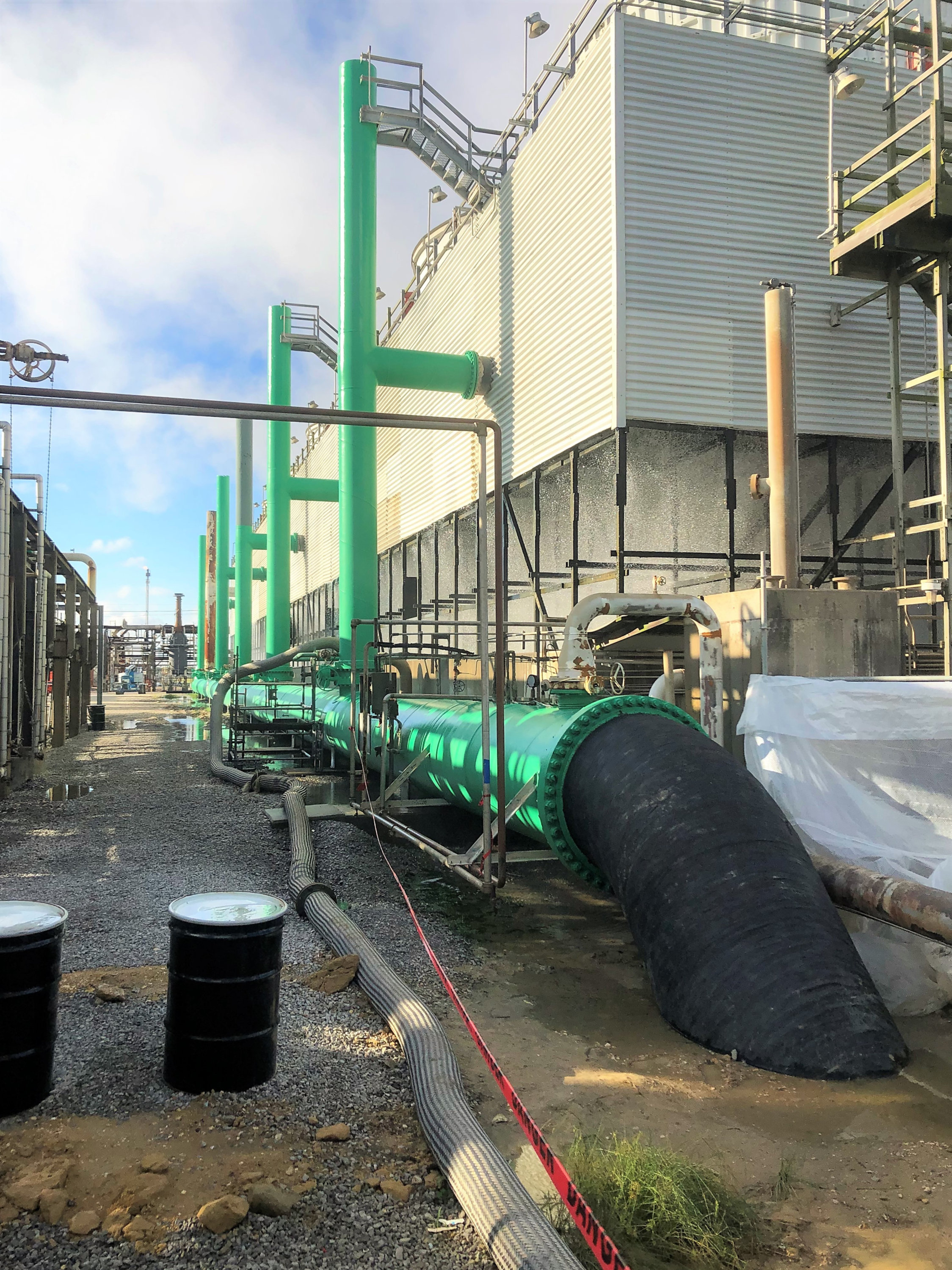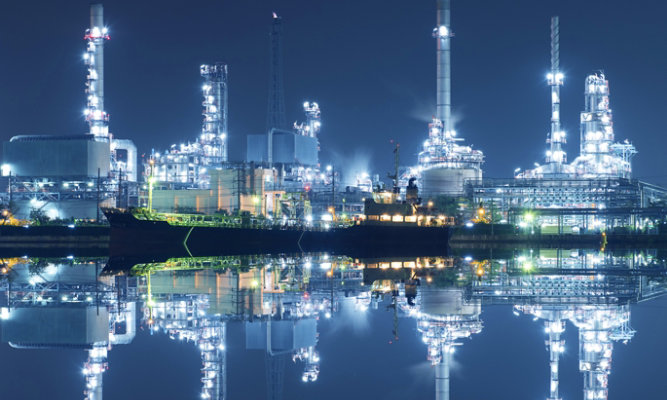
Micaceous Iron Oxide-Enriched Coating System Boosts Corrosion Protection in Fallout Areas
New solution devised for Texas petrochemical plant delivers longer-term asset protection to refineries and chemical plants
By Thomas Crenshaw, Oil & Gas Business Development Manager, and Brian Anderson, Protective Coatings Specialist, both from Sherwin-Williams Protective & Marine
Contact Us to Learn More
What goes up must come down. So go the mist and particles emitted from refinery and chemical plant cooling towers. Lifted into the air from the towers by the wind, this mist of fine specks of chemicals and other contaminants, known as fallout, later settle onto coated steel surfaces throughout a plant. There, they can contribute to the accelerated deterioration of protective coatings, causing premature degradation that leads to corrosion and the need for early maintenance (often as early as six months) – especially due to the high frequency of wet/dry cycling that occurs on exposed assets (Figure 1). Changes in wind direction throughout the year also compound the fallout exposure.
Accelerated coating deteriorations due to fallout prompted a Gulf Coast-based producer of products derived from petrochemical raw materials, including C4 hydrocarbons, to seek a new solution from Sherwin-Williams Protective & Marine. During a routine inspection of facility assets, maintenance managers at the Southeast Texas plant noticed severe pitting and corrosion on steel assets that had been newly installed two years prior. The coated assets, including piping, tanks, spheres, exchangers and structural steel, were expected to withstand corrosion with minimal coating deterioration for at least 10 years before maintenance would begin. Yet, in a much shorter time, the coatings exhibited undercutting corrosion and required unplanned repairs to retain the integrity of the assets they are protecting.
Recognizing the inefficiencies and added costs associated with premature coating degradation and unplanned maintenance, Sherwin-Williams Protective & Marine developed a more robust protective coating system that would offer longer maintenance intervals for the Texas plant. Product development mangers and lab technicians arrived at a new system – consisting of a zinc primer and an intermediate epoxy coat, both enriched with micaceous iron oxide (MIO), with a polysiloxane topcoat – that should last more than 10 years in severe fallout environments. The system has performed significantly better than the original coatings after two years of service. As a result, the petrochemical producer is now using this system to prolong the life of new and rehabilitated assets throughout its locations.
Fallout Leads to Early Coatings Deterioration
With particle fallout from its own operations, as well as from multiple surrounding processing facilities in the region, the Texas plant faces high levels of chemical contamination settling onto steel plant surfaces. Rainstorms, dew and condensation deposit moisture on these surfaces as well, creating recurrent wet/dry cycling that leaves water in frequent contact with fallout contaminants on the steel. This contaminant-laden water accelerates corrosive attacks on the coatings, threatening their ability to protect the underlying steel substrate from corrosion.
The coating system originally specified to protect the plant’s assets consisted of a primer layer of an inorganic or organic zinc-rich primer, topped with a high-build or mastic epoxy intermediate coat and a polyurethane topcoat. Other areas tried a glass flake-filled amine epoxy with a polyurethane topcoat. Both systems work very well in many environments and remain highly recommended solutions. However, the level of fallout experienced at the Texas plant created a more corrosive environment that required a more robust system than these. The issue became evident when inspecting various assets two years after their installation. In this short time, the original coating system displayed significant degradation in all layers and visible undercutting corrosion. While none of the assets required steel repairs, immediate coatings touchups were needed to preserve the integrity of the structures and mitigate the corrosion to prevent leaks.
The early coating deterioration and resulting increased maintenance needs were not acceptable to either the petrochemical producer or Sherwin-Williams Protective & Marine. Both parties knew a better option was likely, so the Sherwin-Williams Technical Service team intervened to investigate solutions for coatings maintenance, as well as original equipment applications. Compounding their exploration of solutions, the team also had to ensure the entire system could be applied via brushes and rollers, as spray applications were not an option when performing maintenance at the operating facility.
A New Coating System Emerges
Knowing that various coating systems were performing well on top of galvanized steel in similar operating environments, Sherwin-Williams wanted to test a zinc-based primer as the base system layer. The team also needed to select a robust primer that offered added protection due to the accelerated corrosion issues associated with fallout contamination. The coating also had to be an organic zinc primer, as inorganic zincs aren’t recommended for maintenance applications. In addition, most epoxy organic zinc primers don’t perform well with high dry film thicknesses (DFTs), when tying in to existing coatings or when performing maintenance in the summer (because they dry too fast). Various testing scenarios revealed that the MIO-enriched Corothane® I MIO-Zinc Primer from Sherwin-Williams was the answer. Infused with plate-like MIO pigments (Figure 2), the primer creates a difficult path for moisture to find its way through the coating to reach the steel substrate – much like with the glass flake-filled epoxies commonly used in cooling tower applications. Applied at 3- to 5-mils DFT, the MIO-zinc primer permits higher film builds in a single coat than other common primers, enabling better coating of pit edges, substrates and tie-ins to existing coatings.
For the intermediate coat, Sherwin-Williams decided on another MIO-enriched formulation, Macropoxy® 267. Pigmented with a high load of MIO, the coating hangs well when applied at higher thicknesses, allowing 5- to 8-mil DFT applications in a single coat even when brushed and rolled. Like the MIO in the primer layer, the pigment in the intermediate coat creates a difficult path for moisture permeation, acting like an umbrella to protect the zinc primer. As such, a 5- to 8-mil DFT application delivers the same low permeation rate as a 20-mil DFT coat of a glass flake-filled epoxy – with far less material, cost and labor involved. This robust protection afforded by the MIO pigments helps to better resist the wet/dry cycling exposed assets face compared to nonreinforced epoxies, which are prone to cracking following heavy wet/dry cycling. The MIO also thickens the coating and enhances edge retention, allowing applicators to achieve higher film builds on piping and sharp edges. The MIO pigments and thicker applications make it much harder for standing water to penetrate the coatings and reach steel substrates.
For the topcoat, the development team knew a polyurethane coating wouldn’t offer sufficient protection based on the performance of the original system. Therefore, the team selected Sherwin-Williams Sher-Loxane® 800, a high-performance epoxy siloxane hybrid that combines the properties of both a high-performance epoxy and a polyurethane. Applied as a 3- to 5-mil DFT topcoat, the polysiloxane coating provides better barrier protection, as well as better water, UV and chemical resistance compared to polyurethanes, which are usually limited to film builds of 2-3 mils DFT. The immersion-grade coating can also withstand the pooling water that sits on various assets without deteriorating.
Depending on weather conditions and the size of the asset being restored, applicators can apply the entire system in a single day. For example, in summer conditions, applicators can wait one hour to apply the intermediate coat after the primer and then two hours to apply the topcoat.
For the coating system, the team drove durability from the top down (Figure 3). The Sher-Loxane 800 topcoat protects the intermediate Macropoxy 267 layer from wear, water and UV exposure. The MIO pigments in the intermediate layer protect the zinc primer from water and also act like mirrors to reflect UV light and mitigate degradation. The same pigments in the primer keep water from reaching the steel substrate to prevent it from attacking the steel and causing the protective zinc to deplete.
Operating and environmental conditions were both important factors in determining an appropriate protective coating system. Asset surface temperatures can be well over 100°F in Texas, and some systems may remain in operation during coating repairs, so each coating needed to be able to be applied in these conditions with enough open time to be workable. Further, certain plant processes are subjected to steam outs that can significantly raise asset surface temperatures. Both the MIO-enriched Corothane I MIO Zinc and Macropoxy 267 coatings meet the elevated temperature requirements for most of the plant’s assets. However, systems subjected to steam outs required a topcoat of HeatFlex® Hi-Temp 500 instead of Sher-Loxane 800 to ensure temperature compatibility.
Coating Life Expectancy Tripled
Sherwin-Williams Protective & Marine worked closely with the Texas petrochemical producer to extend the life of coatings used in fallout areas. A team surveyed the entire plant to determine what assets needed to be addressed and when. After developing the MIO-enriched coating system, Technical Service representatives from Sherwin-Williams trained the plant’s maintenance team on proper coating methods from surface prep to final applications.
To help manage costs and reduce waste, Sherwin-Williams adjusted packaging options for the petrochemical facility. Rather than shipping coatings exclusively in five-gallon quantities that would need to be used all at once after mixing, the company offered smaller kits. Applicators are therefore able to mix less material at a time to address smaller jobs, reducing waste.
Enriched with MIO reinforcements and topped with a durable polysiloxane, the Corothane I MIO Zinc/Macropoxy 267/Sher-Loxane 800 system is expected to combat corrosion and retain its color and gloss for 10 years or longer. That’s more than three times the three-year maximum life the originally specified systems offered. To confirm the coatings will remain sound, the facility is inspecting their fitness every three months on critical assets. These visual inspections are meant to catch any noticeable coatings deterioration and corrosion. Moving on to year three following initial maintenance touchups, the new system looks nearly the same as when first applied with excellent color and gloss and no signs of the early pitting and corrosion the original system encountered. It is now the standard specified coatings system for the Texas-based producer’s three locations.
| MIO Reinforcement Outperforms Glass Flake Alternatives |
|---|
|
MIO Reinforcement Outperforms Glass Flake Alternatives
As Sherwin-Williams brainstormed a more appropriate coating system to withstand the accelerated coating degradation caused by fallout contamination and wet/dry cycling, the team considered glass flake-filled epoxies. Such coatings feature flakes of glass that create a more difficult path for moisture to penetrate the coatings and reach the steel substrate, much like MIO pigments do. However, the glass flake option offered two drawbacks compared to the MIO-enriched option. First, glass flake-filled epoxies require an applied DFT of 20 to 30 mils to effectively protect against moisture penetration, which is more than double the 5 to 8 mils required for the Macropoxy 267 coat. Because applicators weren’t allowed to spray coatings at the Texas facility, they would have needed to apply two or more coats of a glass flake-filled epoxy to achieve the same lower permeation level that the single coat of MIO-filled Macropoxy 267 offered. The chosen system therefore saves the plant at least a couple of days of work on projects, as well as a lot of labor costs. Second, glass flake-filled epoxies do not feature corrosion inhibitors like the Macropoxy 267 coating does. Once the glass-flake epoxy develops a pinhole or is damaged, corrosion undercutting is inevitable and may occur rapidly. |
Figure 2. MIO pigments form a barrier that deflects UV rays, protecting coating layers and the substrate below from degradation. The particles’ layered structure also creates a harder path for water permeation.
Figure 3. The new MIO-enriched coating system for fallout areas promotes durability from the top down, with a Sher-Loxane 800 topcoat, Macropoxy 267 intermediate coat and Corothane I MIO Zinc Primer.
ABOUT THE AUTHORS
Thomas Crenshaw is Oil & Gas Business Development Manager for Sherwin-Williams Protective & Marine. He has more than 30 years’ experience in the protective coatings industry and is responsible for supporting new growth opportunities in the oil and gas and petrochemical industries. Crenshaw is a NACE International Level 3 Certified Coating Inspector. He holds a bachelor’s degree in marketing and management from Oklahoma State University. He can be reached at thomas.crenshaw@sherwin.com.
Brian Anderson is a Protective Coatings Specialist for Sherwin-Williams Protective & Marine. He has been with Sherwin-Williams for 20 years, serving the last seven within the oil and gas and petrochemical industries. For those industries he has held both technical service and sales roles, helping contactors apply coatings properly and ensuring owners can successfully solve their asset protection needs. Anderson is a NACE International Level 2 Certified Coating Inspector. He holds a bachelor’s degree from Angelo State University. He can be reached at brian.anderson@sherwin.com.
Discover More
Industry Expertise and Innovation
See how we help customers find customized solutions for their project and application challenges.
Our Oil & Gas Expertise
Explore our industry solutions and technology to help protect your assets.
LEARN MOREProduct Lookup
Find out more about our innovative coatings for a variety of industries.
FIND A PRODUCT

